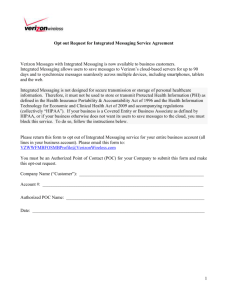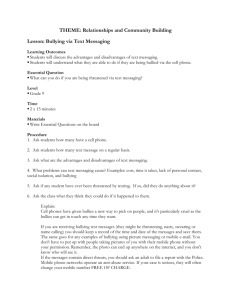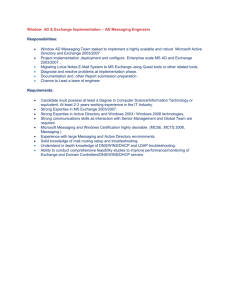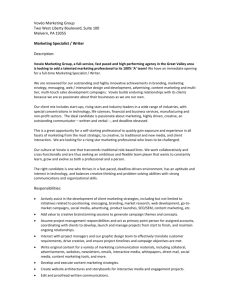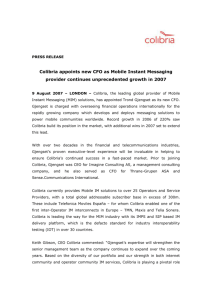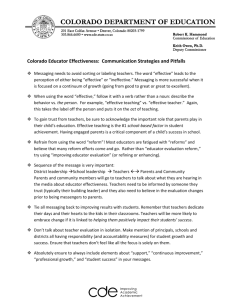File - Engl1312: Text Messaging
advertisement
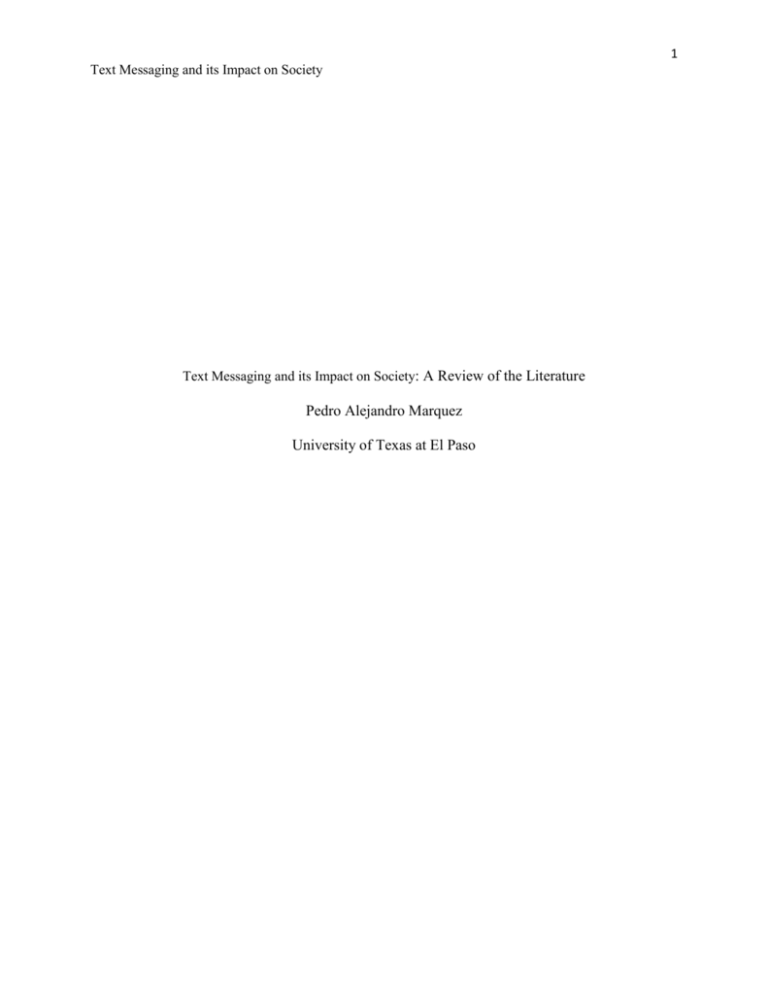
1 Text Messaging and its Impact on Society Text Messaging and its Impact on Society: A Review of the Literature Pedro Alejandro Marquez University of Texas at El Paso 2 Text Messaging and its Impact on Society Abstract The act of typing and sending a brief, electronic message between two or more portable devices over a phone network is now one of the major means of communication in the world. The number of text messages sent monthly in the U.S. exploded from 14 billion in 2000 to 188 billion in 2010. Even though text messaging can serve as a quick, efficient, cheap and convenient way of communication with anyone around the world, there has been recent controversy regarding in its effectiveness and impact in society. Text messaging allows people to build, maintain, and sustain relationships, organize events and social gatherings, and share new and exciting experiences with their friends, but during the last years, text messages have grown in a considerable number provoking the increase of health risk factors and other negative consequences which require state policies in order to stop this issue. 3 Text Messaging and its Impact on Society Text Messaging and its Impact on Society: A Review of the Literature With the popularity of cell phones and other gadgets, it’s no surprise some of that technology affect strongly our lives and changes social interactions. Texting is a phenomenon emerged in the digital society, and it is defined as the act of sending text messages, either through cell phones or social networks to keep in touch and informed. Text messages traditionally don't exceed 160 characters, including spaces. The term originally referred to messages sent using the Short Message Service (SMS); it has grown to include messages containing image, video, and sound content by the Multimedia Messaging Service (MMS). Each new communication medium provides different combinations and levels of way to facilitate and constrain social connections. These different patterns of connectivity in turn both represent and influence forms of social control. Even though text messaging serves as a quick and easy way of communication with anyone around the world, there has been recent controversy regarding in its effectiveness and impact in society. According to a 2012 study from Pew Research, texting has become the preferred way of communication among the younger generations, but in order to understand how is text messaging functioning and affecting in today's teen and young adult students, some important questions need to be considered: 1. In what ways text messaging has change the current ways of communication? 2. How does text messaging affects students in education and social interactions? 3. How does text messaging affects society and what policies were created? The following review on literature will: provide information regarding texting functioning, explore its uses, discuss how it shift ways of communication and its impact in society, and finally how government interfere in this issue. In what ways text messaging has change the current ways of communication? 4 Text Messaging and its Impact on Society In order to understand how texting is affecting people in different discourse communities, the effects of texting over the current ways of communication should be investigated. Some 75% of American teens own cell phones and 88% of them send and receive text messages (Purcell, 2010). Smith (2011) study found the following: Young adults are the most avid texters, cell owners between the ages of 18 and 24 exchange an average of 109.5 messages on a normal day that works out to more than 3,200 texts per month and the typical or median cell owner in this age group sends or receives 50 messages per day (or 1500 messages per month), (p. 2). Figure 1 shows 50 surveys that were made to students from The University of Texas at El Paso (UTEP), which asked if they have a device that allows texting. This question "Do you have a device that allows you text?," informs that all of the participants have a device that can be used for texting, so its inferred that texting is a very easy and available way to communicate ( Marquez, P. survey, 10/25/2013). Question 1 Do you have a device that allows you text? 100% YES NO 0 10 20 30 40 50 60 Figure 1 shows that all the participants in this survey have a device for texting. Although these results are not of the entire United States population, Figure one shows in a selected group the facility that young adults have for acquiring a texting device. 5 Text Messaging and its Impact on Society Figure 2 demonstrates the 50 surveys that asked students how they prefer to be contacted, either by a phone call or a text message?" The results of how they prefer to be contacted on their cell phones, show that 38% prefer texts to talking on the phone, while 46% prefer a voice call to text message. Another 16% said the contract method they prefer depend on the situation. This question presents texting as a common contemporary use of communication (Marquez, P. survey, 10/25/2013). Question 2 How you prefer to be contacted, either by phone call or text message? 16% Phone Call 46% 38% Text Message Depend on Situation Figure 2 shows 38% of the participants in this survey prefer being contacted by text messages. The chart demonstrates how texting has become a current useful tool for communication in a selected small group of young people. Texting had leaved behind old ways of communications like the telegraph, letters, fax, beeper, etc. According to a CNN article published by Jeffrey Kluger (2012), "The telephone is a dying institution. The number of text messages sent monthly in the U.S. exploded from 14 billion in 2000 to 188 billion in 2010"(para.3). 6 Text Messaging and its Impact on Society Does texting is displacing face-to-face communication? Face-to-face communication is the oldest type of communication, it existed since early times people invented a language and a way to talk between them, but now persons are able to choose different medias for communication. Even if face-to-face is the most efficient way of communication, texting has become more popular among teens. Lenhart, Ling, Campbell and Purcell conducted a survey in 2010 that asked teens about their methods of communication to contact their friends. The results from this survey demonstrate that 54% of teens aged 12-17 choose texting, so it is the preferred type of communication among teens. Methods of Communication with Friends Figure 3, presents the results from a Pew Research Center's survey applied to teens, ages 12-17. Doctor Morgan, an expert on communications from the University of Massachusetts, mention during an interview in 2009 that " mass communication is leaded by the internet and has change the previously existing technologies which are television, radio, and newspapers.” As publishers migrate toward digital products and services, text messaging is fast becoming part of that change. In addition to make promotions, newspapers and magazines are offering mobile classifieds, mobile dating services and breaking news alerts. The New York Times launched a 7 Text Messaging and its Impact on Society text messaging service to distribute news, features and columns from its newspaper. The person just need to sign up in order to obtain specific columnist or section text. Texting has become a tool that is changing the way how massive communication is given. How does text messaging affects students in education and social interactions? The use of texting can have either a positive or negative impact on students' communications and education. Text messaging is very common, especially among college students, because of the convenience. Cell phones and text messaging are common on college campuses as over 97% of college students own a cell phone and 94% of college students were text messaging daily from 2005-2007 (Hudson, Bliss and Fetro, 2007). Text messaging may even be addicting (Lee & Perry, 2007). College students text in class, on dates, in the movie theatre, at the office, in the mall, and even text while driving. Figure 4 shows a survey done to 50 students from The University of Texas at El Paso, the results demonstrate that 82% of the students text during classes (Marquez, P. survey, 10/25/2013). Question3 Do you send text messages during classes? YES NO 0 5 10 15 20 25 30 35 40 45 Figure 4 shows the great amount of students that send text messages during classes. A (2012) survey among college students by Tindell and Bohlander claim that " It was found that 95% of students bring their phones to class every day, 92% use their phones to text message during class time, and 10% admit they have texted during an exam on at least one 8 Text Messaging and its Impact on Society occasion". Both survey confirm that the amount of college students that send text messages in the United States is higher than the ones who don't. It is important to consider why college students use text messages in order to understand the positive or negative impact on their education. College students use text for four main reasons. First, college students use text messages to coordinate plans. Hagen and Rice (2007) study found that text messaging was mostly used for coordinating, a great amount of college students mass text their classmates to organize how they are doing group homeworks. Text messaging could simply be used by college students to plan and coordinate with others for a night, meeting or other things. Second, college students use text messaging to multitask. Text messaging is convenient, fast, and easy. Most of the students text someone as they are brushing their teeth, singing a song, eating food, in class, playing a game, or at work. Some students even text while driving, which could endanger the public or even themselves. A convenience of text messaging is that the receiver do not need to answer the text right away. Any person can answer the text message whenever they want and it will be delivered successfully. Multi-tasking has some negative aspects such as decreased performance being and distractions changes the persons memories (Gaither, 2008). Texting in class cause the loss of information provided by the professors, because the student is not either paying attention or taking notes. Third, college students use text messages to stay in contact. Text messaging is an easy way to show someone you care. According to Horstmanshof and Power (2005), "one key function of SMS across age groups is relationship maintenance." Nowadays, most of young students live away from their family and friends, so they use text messages in order to maintain 9 Text Messaging and its Impact on Society their relationships. Lin and Tong (2007) agree text messaging is a good way to keep in contact with those we love, who are far away. In 2004, Reid and Reid surveyed over 1,000 participants to explore the social and psychological effects of texting and found that texting helps develop new relationships, increases social agenda, and maintains old relationships. In contrast, those who prefer texting over talking on the phone were more likely to report that texting had negatively affected relationships with their family and friends. Fourth, some college students send text messages to avoid face to face communication and therefore reduce social interaction (Lee & Perry, 2007, p. 74). Adams, Baker, Daufin et al.(2008) agree with this notion of the displacement of face to face communication. According to James, Wotring, & Forrest (1995) study college students are finding limited amount of time for relaxing and need to use their time wisely, in which text messaging saves them on time. According to Lin and Tong (2007), text messaging is a good way to communicate after a fight. Persons do not have to hear the other person's voice, but they still trying to resolve the problem. There are strong reactions from the public, media, and language experts that the use of "textisms" can transfer to formal writing in the form of deterioration of spelling and misuse of language. These individuals are alarmed about the effect of text messaging on the language and literacy development of school age children. Some studies have found that today’s teens are reading and writing more than any other generation because they engage in many different forms of written communication besides texting to include blogging and emailing (Baggott, 2006). Researchers with The Miriam Hospital’s Centers for Behavioral and Preventive Medicine found that media use, in general, was associated with lower grade point averages (GPAs) and other negative academic outcomes. Texting in classes is related to loss of information and the 10 Text Messaging and its Impact on Society loss of information lead to bad grades this statement was proved in an Fang-Yi, investigation from Fang-Yi, Wang and Klausner (2012). How does text messaging affects society and what policies were created? Text messaging is considered a public health risk factor as well as a public health protective factor. Along with the many benefits of text messaging, there is evidence that text messaging is related to a variety of physical and psychological health issues such as: increased stress and anxiety levels, interrupted sleep, hand and neck pain, increased heart and breathing rate, psychological discomfort, depression, and social anxiety (Hudson, Bliss and Fetro, 2012). The greatest public health issue involving text messaging is text messaging while driving. Text messaging while driving poses the biggest health risk by causing serious injury or death due to vehicle crashes from distracted driving. In 2009, 995 vehicle fatalities in the United States involved reports of cell phone usage as the distraction (U.S. Department of Transportation, 2010). In addition, data from the Fatality Analysis Reporting System and National Automotive Sampling System estimated 24,000 injuries involved reports of cell phone as a distraction (U.S. Department of Transportation, 2010).Figure 5 shows that 28% percentage of participants use texting devices while driving (Marquez, P. survey, 10/25/2013). Question 4 Do you text while driving? 72% NO 28% YES 0 5 10 15 20 25 30 Figure 5 shows the percentage of people that text and drive. 35 40 11 Text Messaging and its Impact on Society Even though the survey was made within a small group of students, a national survey on distracted driving support the results. The national survey found that 18% of drivers reported that they had sent text messages or e-mails while driving. Moreover, 49% of those who text messaged while driving were 21 to 24 years old (Hudson, Bliss and Fetro, 2011). According to Governors Highway Safety Association (2013) "several states have passed laws against texting, “39 states, D.C., Puerto Rico, Guam and the U.S. Virgin Islands ban text messaging for all drivers. All but 4 have primary enforcement” (para.4). In contrast, text messaging has been used on college campuses, and other institutions, as a public health and safety practice. The U.S. Department of Education requires university and colleges to have a system to communicate with their students in a timely manner in the event of an emergency (U.S. Department of Education, 2007). Several educational institutions have adopted text messaging alert system to protect students against bad weather or dangerous events on campus. Now with more sophisticated phones and smart devices, texting has spilled over into the business world and become a hit in adults. Today text messaging is used by several companies to easily confirm deliveries, send product alerts, provide fast client contact, pass along important information in a meeting, schedule meetings and for a quick communication among workers. Marketing plays an important role in text messages, businesses can have their customers subscribe to their texting service and be the first ones to know about an exclusive offer, a special event, discounts, or coupons. A survey conducted in around 500 employees by businesses in the U.S. estimated that companies with greater than 1,000 employees, lost $10 million each year through decreased productivity caused by various types of digital distractions such as text messaging, social networks or private emails (Anderson, 2013). Texting at work, as in school, is 12 Text Messaging and its Impact on Society hard for management to stop because it is silent. Most companies have banned private email at work, with all email traffic being monitored, but no such policies can be imposed on texting as employees silently use their personal devices. Conclusion Even though most teens and college students agree that face-to-face communication is more helpful than a text message, college students’ behaviors still favor text messaging. Text messaging would not be so favored if there were no personal and social benefits by using this communication method. Text messaging allows people to build, maintain, and sustain relationships, organize events and social gatherings, and share new and exciting experiences with their friends. During the last years, text messages have grown in a considerable number provoking the increase of health risk factors and other negative consequences which require state policies in order to stop this issue. 13 Text Messaging and its Impact on Society References Adams, J., Baker, K., Daufin, E.K., Ellington, C., Emanuel, R., Fitts, E., Himsel, J., Holladay, L. & Okeowo D. (2008). How college students spend their time communicating. International Journal of Listening, 22(1), 13-28. Anderson, J. (2013). Texting at Work and Social Media Distractions Costing Billions. Hub Pages. Retrieved 10/29/2013 from http://janderson99.hubpages.com/hub/Texting-atWork-and-Social-Media-Distractions-Costing-Billions Baggot, K. (2006) Literacy and Text Messaging. MIT Technology Review. Retrieved 11/02/2013 from http://www.technologyreview.com/news/407022/literacy-and-text-messaging/ Fang-Yi, F. W., Wang, I. K., & Klausner, M. (2012). Rethinking College Students' SelfRegulation and Sustained Attention: Does Text Messaging During Class Influence Cognitive Learning? Communication Education, 1.DOI: 10.1080/03634523.2012.672755 Gaither, C. (2006). They do it all while studying: At homework time, many students also are playing games, e-mailing friends and watching TV. Los AngelesTimes. Retrieved 11/01/2013 from http://www.latimes.com/business/lafipollhomework11aug11,0,7979479. Governors Highway Safety Association. (2013). Distracted driving laws. Retrieved from http://www.ghsa.org/html/stateinfo/laws/cellphone_laws.html. Hagen, I., & Rice, R. E. (2007). Young Adults Perpetual Contact, Social Control through the Internet and Mobile Phones. Communication Yearbook, 34, 1-39. Retrieved 11/3/2013 from http://www.comm.ucsb.edu/faculty/rrice/A102RiceHagen2010CY34.pdf Hemmer,H. (2009) Impact of Text Messaging on Communication. Journal of Undergraduate Research at Minnesota State University. Retrieved 11/02/2013 from http://www.mnsu.edu/urc/journal/2009/hemmer.pdf 14 Text Messaging and its Impact on Society Horstmanshof, L., & Power, M. R. (2005) Mobile phones, SMS, and relationships: issues of access, control, and privacy. Australian Journal of Communication, 32(1), 33-52. Hudson, H. K., Bliss, K. R. and Fietro, J. V. (2012). Effects of Text Messaging on College Students Perceptions of Personal Health. The Health Educator, 44(1), 28-35. James, M. Wotring. C . & Forrest. E. (1995). An exploratory study of the perceived benefits of electronic bulletin board use and their impact on other communication activities. Journal of Broadcasting and Electronic Media. 39(1) 30-50. Joe Murphy Librarian (2012). Text Messaging turns 20, has change the way we communicate and slows in the face of a new tech landscape. Joe Murphy. Retrieved 10/25/2013 from http://joemurphylibraryfuture.com/text-messaging-turns-20-has-changed-the-way-wecommunicate-and-slows-in-the-face-of-a-new-tech-landscape/ Kluger, J. (2012). We never talk any more: The problem with text messaging. Retrieved from http://www.cnn.com/2012/08/31/tech/mobile/problem-text-messaging-oms Lee, K.C. & Perry, S.D. (2007). Mobile phone text messaging overuse among developing World university students. Communication: South African Journal for Communication Theory & Research, 33(2), 63-79. DOI: 10.1080/02500160701685417. Lenhard, A., Ling,R., Campbell, S., Purcell, K. (2010). Teens and Mobile Phones. Pew Internet & American Life Project. Retrieved 11/01/2013 from http://www.pewinternet.org/Reports/2010/Teens-and-Mobile-Phones/Chapter-1/Howthe-economics-of-mobile-phones-affects-cell-use.aspx. Leung, L. (2007). Unwillingness-to-communicate and college students‟ motives in SMS mobile messaging. Telematics & Informatics, 24(2), 115-129. 15 Text Messaging and its Impact on Society Lin, A. M. Y., & Tong, A. (2007). Text-messaging cultures of college girls in Hong Kong: SMS as resources for achieving intimacy and gift-exchange with multiple functions. Continuum: Journal of Media and Cultural Studies, 21 (2), 303-315. Morgan, M. (2009). Mass communication : Effects of technology on mass communication. Retrieved 10/22/2013 from http://www.youtube.com/watch?v=HiY-Ta_MOyo Power, M. R. & Power, D.(2004). Everyone Here Speaks TXT: Deaf People Using SMS in Australia and the Rest of the World. Journal of Deaf Studies and Steaf Education. 9(3), 333-343. Purcell, K. (2010). Teens, the Internet and Communication Technology. Pew Internet & American Life Project. Retrieved 10/26/ 2013 from http://www.pewinternet.org/~/media/Files/Presentations/2010/Jun/Purcell%20YALSA% 20pdf.pdf. Reid, D., & Reid, F. (2005). Textmates and text circles: Insights into the social ecology of SMS text messaging. Mobile World: Past, present and future, 105-118. DOI:10.1007/184628-204-7_7 Salaway, G., Caruso, J. B., & Nelson, M. R. (2007). The ECAR study of undergraduate students and information technology. Retrieved from http://connect.educause.edu/library /TheECARStudyofUnderg/45075. Smith, A. (2011). Americans and Text Messaging. Pew internet and American Life Project. Retrieved 10/25/2013 from http://pewinternet.org/Reports/2011/Cell-Phone-Texting2011/Summary-of-Findings.aspx Tindell, D. R. and Bohlander, R. W. (2012). The use and abuse of cell phones and text messaging in the classroom: A survey of college students. College Teaching, 60 (1), 1-9. 16 Text Messaging and its Impact on Society U. S. Department of Transportation. (2010). Traffic Safety Facts. Washington, D.C.: U.S. Government Printing Office. Walsh, J. L. (2013). Texting, Social Networking and Other Media Use Linked to poor academic performance.
